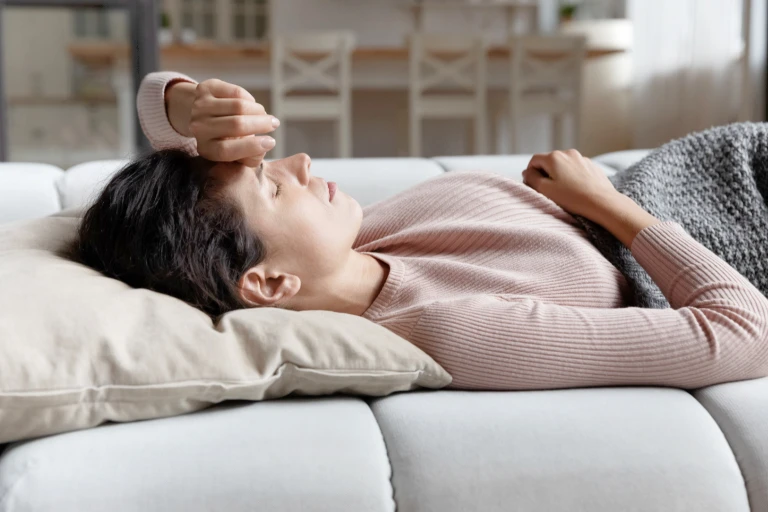What causes menstrual migraines during your period?

Understanding Menstrual Migraines
Have you ever experienced migraines during your period? Migraines are a complex neurological condition with a variety of symptoms, typically involving moderate to severe headaches. They are highly disabling, difficult to treat, and strongly affect quality of life.
Women are 2-3 times more likely to suffer from migraines than men. They suffer from them more frequently and they usually last longer. It’s hard to say whether the pain intensity is worse for women or men because of subjectivity and gender bias of what is considered painful.
Studies show up to 21% of women suffer from migraines that occur around their periods, called menstrual migraines (catamenial migraines). There are two types of menstrual migraines: true and related. True menstrual migraines exclusively happen around the start of menstruation, whereas related menstrual migraines can occur outside of your period. Some women (8%) experience them during every period, while others may have them less frequently. exciting and I can’t wait to share our developments with you!
What is the difference between migraines and menstrual migraines?
Menstrual migraines typically occur anywhere between 2 days before menstruation to 3 days into bleeding. It feels like a strong throbbing or pulsing sensation, usually on one side of the head.
Compared to regular migraines, menstrual migraines last longer (sometimes past 72 hours) and are less responsive to medical treatment. They are also associated with additional symptoms such as fatigue, sleep difficulty, nausea and indigestion.
What causes menstrual migraines?
Right before your period, there is a drop in oestrogen. On average, this reduction starts around 5 days before menstruation; oestrogen levels do not typically start to rise again until day 3 of your period. These hormonal fluctuations have been found to trigger menstrual migraines.
- Inflammation: Oestrogen is a hormone that acts like a chemical messenger in our bodies, controlling many inflammatory pathways in the brain involved with migraines. Certain proteins in the body are linked to inflammation and migraines, and oestrogen helps to protect against this inflammation by reducing the release of these proteins. This means that oestrogen can lower the inflammation in the body, and when oestrogen levels drop, the risk of inflammation could increase.
- Blood vessels dilation: Oestrogen fluctuations can trigger a series of pathways in the brain. When oestrogen levels drop, it can lead to blood vessel dilation, causing the release of inflammatory molecules that increases the sensitivity of nerves to pain, resulting in a migraine.
- Serotonin drops: Oestrogen can affect the level of different neurotransmitters in the brain. Neurotransmitters like serotonin are responsible for carrying messages between nerve cells, particularly for pain sensation and perception. When oestrogen levels drop, it is theorised that serotonin levels also drop. This leads to vasodilation, increased sensitivity of nerves, and menstrual migraines.
Who is affected by menstrual migraines?
- People with chronic pelvic pain:A clinical trial found that 70% of people who had chronic pelvic pain also had migraines. In this group, 53% stated their migraines happened around their periods. Chronic pain conditions are more likely to increase nerve sensitivity, which may explain the link to migraines.
- People with endometriosis or adenomyosis:People with endometriosis are more likely to suffer from menstrual migraines (37%) compared to people without the condition (15%). The risk is similar between mild and moderate endometriosis, but was considerably higher in severe endometriosis. Individuals with co-existing endometriosis and adenomyosis were 2 times more likely to suffer from menstrual migraines than individuals with only endometriosis. While the reasons are unclear, the high inflammation from endometriosis lesions may activate nerves, potentially triggering migraines.
- People with heavy periods: Heavy periods have also been linked to menstrual migraines, and is especially worse when the patient develops anaemia due to heavy bleeding. This is because heavy bleeding can mean less iron and red blood cells are available to carry oxygen through the body, potentially resulting in headaches or migraines.
- Transgender people: It is well known that menstrual migraines have a strong link to hormone fluctuations. This may be apparent in transgender females undergoing oestrogen therapy. One study found that people undergoing male-to-female transitions experienced similar levels of migraines to cis females, compared to cis males who had the lowest levels of migraines.
Read on our next article as we explore different ways to cope with menstrual migraines: Managing menstrual migraines
Written by Joii Team